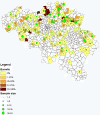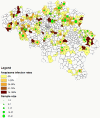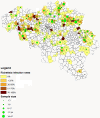Ticks and associated pathogens collected from dogs and cats in Belgium
- PMID: 23777784
- PMCID: PMC3688525
- DOI: 10.1186/1756-3305-6-183
Ticks and associated pathogens collected from dogs and cats in Belgium
Abstract
Background: Although Ixodes spp. are the most common ticks in North-Western Europe, recent reports indicated an expanding geographical distribution of Dermacentor reticulatus in Western Europe. Recently, the establishment of a D. reticulatus population in Belgium was described. D. reticulatus is an important vector of canine and equine babesiosis and can transmit several Rickettsia species, Coxiella burnetii and tick-borne encephalitis virus (TBEV), whilst Ixodes spp. are vectors of pathogens causing babesiosis, borreliosis, anaplasmosis, rickettsiosis and TBEV.
Methods: A survey was conducted in 2008-2009 to investigate the presence of different tick species and associated pathogens on dogs and cats in Belgium. Ticks were collected from dogs and cats in 75 veterinary practices, selected by stratified randomization. All collected ticks were morphologically determined and analysed for the presence of Babesia spp., Borrelia spp., Anaplasma phagocytophilum and Rickettsia DNA.
Results: In total 2373 ticks were collected from 647 dogs and 506 cats. Ixodes ricinus (76.4%) and I. hexagonus (22.6%) were the predominant species. Rhipicephalus sanguineus (0.3%) and D. reticulatus (0.8%) were found in low numbers on dogs only. All dogs infested with R. sanguineus had a recent travel history, but D. reticulatus were collected from a dog without a history of travelling abroad. Of the collected Ixodes ticks, 19.5% were positive for A. phagocytophilum and 10.1% for Borrelia spp. (B. afzelii, B. garinii, B. burgdorferi s.s., B. lusitaniae, B. valaisiana and B. spielmanii). Rickettsia helvetica was found in 14.1% of Ixodes ticks. All Dermacentor ticks were negative for all the investigated pathogens, but one R. sanguineus tick was positive for Rickettsia massiliae.
Conclusion: D. reticulatus was confirmed to be present as an indigenous parasite in Belgium. B. lusitaniae and R. helvetica were detected in ticks in Belgium for the first time.
Figures




Similar articles
-
Diversity of ticks and tick-borne pathogens in ticks removed from dogs and cats: a focus on Poland, Czech Republic, Slovakia, Hungary, and Romania.Parasit Vectors. 2025 Jul 21;18(1):290. doi: 10.1186/s13071-025-06852-6. Parasit Vectors. 2025. PMID: 40691614 Free PMC article.
-
Detection of selected pathogens in ticks collected from cats and dogs in the Wrocław Agglomeration, South-West Poland.Parasit Vectors. 2016 Jun 21;9(1):351. doi: 10.1186/s13071-016-1632-0. Parasit Vectors. 2016. PMID: 27329450 Free PMC article.
-
Detection of tick-borne pathogens in ticks from dogs and cats in different European countries.Ticks Tick Borne Dis. 2018 Sep;9(6):1431-1436. doi: 10.1016/j.ttbdis.2018.06.013. Epub 2018 Jul 3. Ticks Tick Borne Dis. 2018. PMID: 29983263
-
Review of ticks attacking domestic dogs and cats, and their epidemiological role in the transmission of tick-borne pathogens in Poland.Ann Agric Environ Med. 2023 Mar 31;30(1):22-30. doi: 10.26444/aaem/161552. Epub 2023 Mar 7. Ann Agric Environ Med. 2023. PMID: 36999852 Review.
-
Dermacentor reticulatus: a vector on the rise.Parasit Vectors. 2016 Jun 1;9(1):314. doi: 10.1186/s13071-016-1599-x. Parasit Vectors. 2016. PMID: 27251148 Free PMC article. Review.
Cited by
-
Assessment of four DNA fragments (COI, 16S rDNA, ITS2, 12S rDNA) for species identification of the Ixodida (Acari: Ixodida).Parasit Vectors. 2014 Mar 3;7:93. doi: 10.1186/1756-3305-7-93. Parasit Vectors. 2014. PMID: 24589289 Free PMC article.
-
Evaluation of In Vivo Acaricidal Effect of Soap Containing Essential Oil of Chenopodium ambrosioides Leaves on Rhipicephalus lunulatus in the Western Highland of Cameroon.J Pathog. 2015;2015:516869. doi: 10.1155/2015/516869. Epub 2015 Dec 6. J Pathog. 2015. PMID: 26770829 Free PMC article.
-
Prevalence of Borrelia burgdorferi and Anaplasma phagocytophilum in Ixodes ricinus collected from dogs in eastern Poland.J Vet Res. 2024 Mar 23;68(1):109-114. doi: 10.2478/jvetres-2024-0015. eCollection 2024 Mar. J Vet Res. 2024. PMID: 38525235 Free PMC article.
-
Field effectiveness and safety of fluralaner plus moxidectin (Bravecto® Plus) against ticks and fleas: a European randomized, blinded, multicenter field study in naturally-infested client-owned cats.Parasit Vectors. 2018 Nov 19;11(1):598. doi: 10.1186/s13071-018-3175-z. Parasit Vectors. 2018. PMID: 30454052 Free PMC article.
-
Comparative speed of kill of oral treatments with Simparica™ (sarolaner) and Bravecto®(fluralaner) against induced infestations of Rhipicephalus sanguineus on dogs.Parasit Vectors. 2016 Feb 24;9:103. doi: 10.1186/s13071-016-1376-x. Parasit Vectors. 2016. PMID: 26911244 Free PMC article.
References
-
- Heile C, Heydorn AO, Schein E. Dermacentor reticulatus (Fabricius, 1794) – distribution, biology and vector for Babesia canis in Germany. Berl Munch Tierarztl Wochenschr. 2006;119:330–334. - PubMed
-
- Dautel H, Dippel C, Oehme R, Hartelt K, Schettler E. Evidence for an increased geographical distribution of Dermacentor reticulatus in Germany and detection of Rickettsia sp. RpA4. Int J Med Microbiol. 2006;296:149–156. - PubMed
-
- Losson B, Mollet JJ, Avez F, Malaise F, Mignon B. Description de trois cas autochtones de Babésiose canine (Babesia canis) en Belgique. Ann Med Vet. 1999;143:119–124.
Publication types
MeSH terms
LinkOut - more resources
Full Text Sources
Other Literature Sources
Miscellaneous

